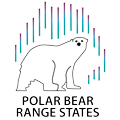Identify strategic communications opportunities for the Range States to provide information regarding the threat to the Arctic and to polar bears from climate change and the need for the global community to reduce GHG emissions
Summary of the Action:
Through Action CCC-A3, a plan will be created that will identify known strategic communication opportunities for the climate change communications work of the Range States. Furthermore, it is expected that collaborative structures will be created that will allow the Range States to continue work with partners to identify future strategic communications opportunities throughout the implementation period.
Action Lead:
Andreas B. Schei (Norwegian Environment Agency, This email address is being protected from spambots. You need JavaScript enabled to view it.)
Polar Bear Range State Participants:
- Lauren Schmuck (Environment and Climate Change Canada)
- Lindsey Mangipane (U.S. Fish and Wildlife Service)
- Jesper Ødegård Jacobsen (Greenland Ministry of Fisheries, Hunting and Agriculture)
- Karen Lone (Norwegian Environment Agency)
- Stanislav Belikov (Russia)
- Angelina Gnedenko (Russia)
- Droplaug Ólafsdóttir (Polar Bear Agreement, Project Officer)
Duration of action:
2020-2022
Deliverables (output):
-
D1. A list of strategic communication opportunities for the Range States to share the products developed through action CCC-A2. This would include key opportunities to communicate with each target audience and suggestions for suitable messages.
Impact (outcome):
Identifying strategic communications opportunities will help create a clear strategy of how to best and most efficiently reach the target-group and disseminate the desired messages. By exploring different opportunities and identifying the most efficient strategic communication approach, in collaboration with invited experts/partnership organizations CCC-A3 will help to lay the groundwork for successfully completing all other actions under Objective 2. The vision of that CAP is "to secure the long-term persistence of polar bears in the wild that represents the genetic, behavioral, life-history, and ecological diversity of the species." The CAP also identifies climate change and the associated reductions in the extent and composition of sea ice to be the greatest threat to polar bear persistence. Therefore, work to communicate to the public, policy makers, and legislators around the world the importance of mitigating GHG emissions to polar bear conservation would provide a substantial contribution toward achieving the vision of the CAP.
Dissemination:
Partners will use their existing communication networks to disseminate messages developed through CCC-A2 to the public and policy makers around the world.

